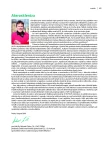How to deal ugly twins, LDL-cholesterol and lipoprotein (a)
Authors:
Jan Piťha 1,2
Authors‘ workplace:
Interní klinika, 2. LF UK a FN v Motole, Praha
1; Laboratoř pro výzkum aterosklerózy, Centrum experimentální medicíny IKEM Praha
2
Published in:
Vnitř Lék 2016; 62(11): 903-907
Category:
Reviews
Overview
LDL cholesterol (LDL-C) remains the primary goal for hypolipidemic therapy as a representative of atherogenic LDL particles. In patients at very high risk, its level should be in the range 0.9–1.6 mmol/l. In patients with progression of atherosclerosis despite treatment, an important role could play high level of lipoprotein (a) – Lp(a), particle with a high atherothrombotic potential. Until now, it was difficult to reduce LDL-C to the desired range by recent therapy: combination of lifestyle changes, high doses of strong statins and ezetimibe. Lp(a) was not affected by these measures at all. Recently, we have the opportunity to reduce significantly LDLc and Lp(a), by two treatment modalities. The first is a lipoprotein apheresis that reduces LDL-C and Lp(a) by 60–80 %. The second one are inhibitors of proprotein convertase subtilisin kexin 9 which lower LDL-C similarly to lipoprotein apheresis; Lp(a), approximately by 25 %. Both methods, or their combination could, therefore, significantly affect prognosis of patients with atherosclerosis out of control, in which the treatment by available therapy have not been successful or not possible for intolerance especially in the case of statins.
Key words:
LDL cholesterol – lipoprotein (a) – lipoprotein apheresis – PCSK9 inhibitors
Sources
1. Informace dostupné z WWW: <http://www.uzis.cz/katalog/rocenky/zdravotnicka-rocenka-ceske-republiky>.
2. Yusuf S, Hawken S, Ounpuu S et al. INTERHEART Study Investigators. Effect of potentially modifiable risk factors associated with myocardial infarction in 52 countries (the INTERHEART study): case-control study. Lancet 2004; 364(9438): 937–952.
3. Catapano AL, Graham I, De Backer G et al. 2016 ESC/EAS Guidelines for the Management of Dyslipidaemias: The Task Force for the Management of Dyslipidaemias of the European Society of Cardiology (ESC) and European Atherosclerosis Society (EAS) Developed with the special contribution of the European Assocciation for Cardiovascular Prevention & Rehabilitation (EACPR). Eur Heart J 2016 Aug 27. pii: ehw272. Dostupné z DOI: <http://dx.doi.org/10.1093/eurheartj/ehw272>.
4. Blaha M, Zadak Z, Blaha V et al. Extracorporeal LDL cholesterol elimination (25 years of experience in CZ). Atheroscler Suppl 2009; 10(5):17–20. Dostupné z DOI: <http://dx.doi.org/10.1016/S1567–5688(09)71804–5>.
5. Bláha V, Bláha M, Lánská M et al. LDL-aferéza: indikace, kontraindikace, klinický význam a vlastní zkušenosti. Hypertenze a kardiovaskulární prevence 2015; 4(1): 47–51.
6. Bláha V, Bláha M, Lánská M et al. LDL-aferéza v léčbě familiárních hyperlipoproteinemií. Vnitřní lékařství 2014; 60(11): 970–976.
7. Stefanutti C, Julius U. Lipoprotein apheresis: state of the art and novelties. Atheroscler Suppl 2013; 14(1):19–27. Dostupné z DOI: <http://dx.doi.org/10.1016/j.atherosclerosissup.2012.10.021>.
8. Winters JL. [American Society for Apheresis]. American society for apheresis guidelines on the use of apheresis in clinical practice: Practical, concise, evidence-based recommendations for the apheresis practitioner. J Clin Apher 2014; 29(4): 191–193. Dostupné z DOI: <http://dx.doi.org/10.1002/jca.21334>.
9. Thompson GR. The evidence-base for the efficacy of lipoprotein apheresis in combating cardiovascular disease. Atheroscler Suppl 2013; 14(1): 67–70. Dostupné z DOI: <http://dx.doi.org/10.1016/j.atherosclerosissup.2012.10.001>.
10. Borberg H. The lower the better: target values after LDL-Apheresis and semi-selective LDL-elimination therapies. Transfus Apher Sci 2013; 48(2): 203–206. Dostupné z DOI: <http://dx.doi.org/10.1016/j.transci.2013.02.003>.
11. Robinson JG, Farnier M, Krempf M et al. [ODYSSEY LONG TERM Investigators]. Efficacy and safety of alirocumab in reducing lipids and cardiovascular events. N Engl J Med 2015; 372(16):1489–1499. Dostupné z DOI: <http://dx.doi.org/10.1056/NEJMoa1501031>.
12. Sabatine MS, Giugliano RP, Wiviott SD et al. Efficacy and safety of evolocumab in reducing lipids and cardiovascular events. N Engl J Med 2015; 372(16): 1500–1509. Dostupné z DOI: <http://dx.doi.org/10.1056/NEJMoa1500858>.
13. Raal FJ, Giugliano RP, Sabatine MS et al. Reduction in lipoprotein(a) with PCSK9 monoclonal antibody evolocumab (AMG 145): a pooled analysis of more than 1,300 patients in 4 phase II trials. J Am Coll Cardiol 2014; 63(13): 1278–1288. Dostupné z DOI: <http://dx.doi.org/10.1016/j.jacc.2014.01.006>.
14. Soška V, Vrablík M, Bláha V et al. PCSK-9 inhibitory – nové možnosti v léčbě hypercholesterolemie: u koho budou indikovány? Stanovisko české společnosti pro aterosklerózu. Vnitř Lék 2016; 62(4): 329–333.
15. Lloyd-Jones DM, Morris PB, Ballantyne CM (Writing Committee) et al. 2016 ACC Expert Consensus Decision Pathway on the Role of Non-Statin Therapies for LDL-Cholesterol Lowering in the Management of Atherosclerotic Cardiovascular Disease Risk: A Report of the American College of Cardiology Task Force on Clinical Expert Consensus Documents. J Am Coll Cardiol 2016; 68(1): 92–125. Dostupné z DOI: <http://dx.doi.org/10.1016/j.jacc.2016.03.519>.
Labels
Diabetology Endocrinology Internal medicineArticle was published in
Internal Medicine

2016 Issue 11
Most read in this issue
- A diet suitable for patients with dyslipidemia and metabolic syndrome
- Hyperlipoproteinemia in children
- Hyperlipoproteinemia and dyslipidemia as rare diseases. Diagnostics and treatment
- Uric acid as a risk factor for cardiovascular diseases
